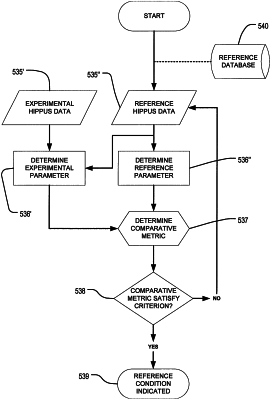| CPC A61B 5/4845 (2013.01) [A61B 3/0041 (2013.01); A61B 3/112 (2013.01); G06T 7/0014 (2013.01); G06T 7/70 (2017.01); G16H 10/20 (2018.01); G16H 15/00 (2018.01); G16H 30/40 (2018.01); G16H 50/20 (2018.01); G16H 50/30 (2018.01); G16H 50/70 (2018.01); G16H 70/40 (2018.01); G16H 70/60 (2018.01); G06T 2207/10016 (2013.01); G06T 2207/30041 (2013.01)] | 15 Claims |

|
1. An apparatus for evaluation of a pupillary hippus of a patient, comprising:
a display; and
processing circuitry configured to
transform experimental data of the pupillary hippus of the patient and reference data via frequency-based transformation,
calculate a first parameter of one or more selected parameters based upon the transformed experimental data of the pupillary hippus of the patient,
calculate, based upon the transformed reference data, a corresponding first parameter of the one or more selected parameters,
generate a metric from the first parameter based upon the experimental data and the corresponding first parameter based upon the reference data, the generated metric being a normalization of the first parameter and the corresponding first parameter,
determine whether the generated metric achieves a predetermined threshold, the predetermined threshold being related to a biologically-active target, and
display, on the display and based upon the determination, the evaluation of the pupillary hippus of the patient, wherein
the evaluation of the pupillary hippus of the patient is an identification of Δ9-tetrahydrocannabinol as the biologically-active target,
wherein the first parameter based upon the experimental data is:
an amplitude at a predetermined frequency,
band power, or
a mathematical model of the experimental data.
|